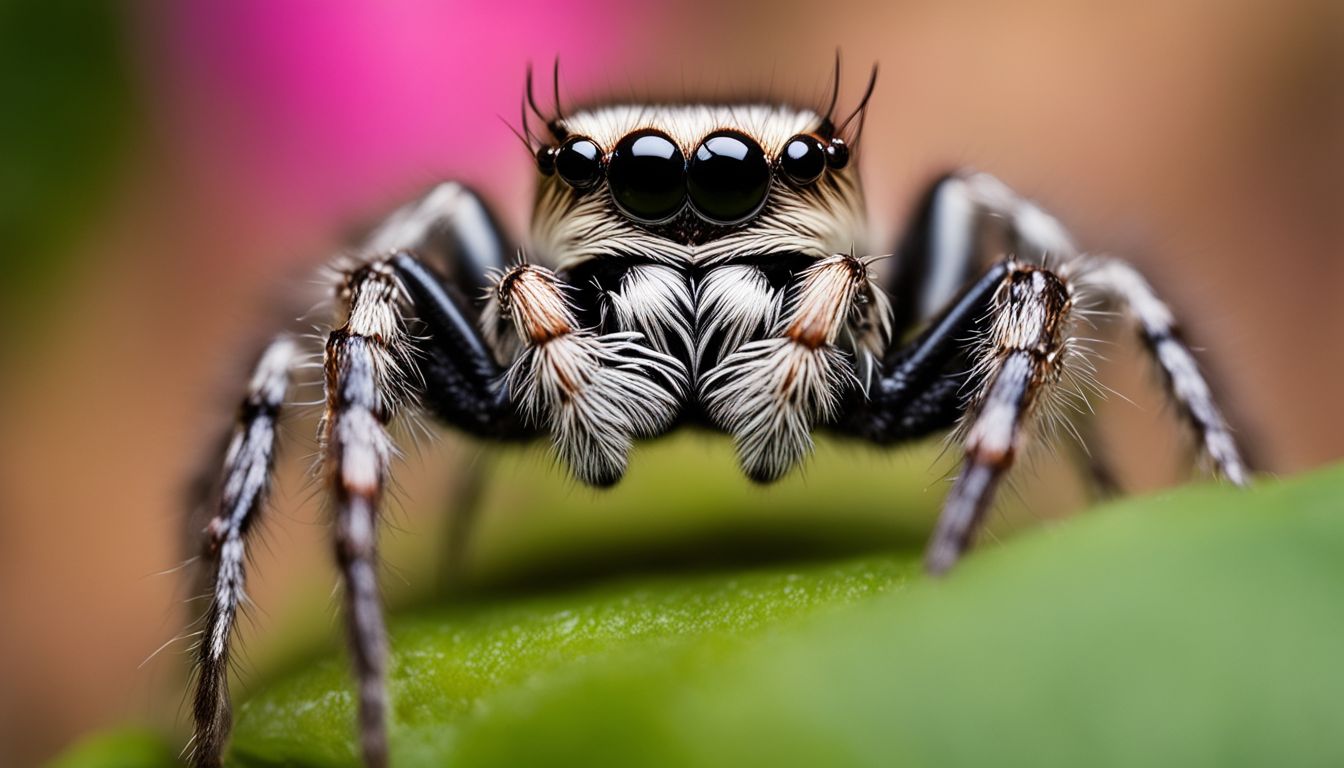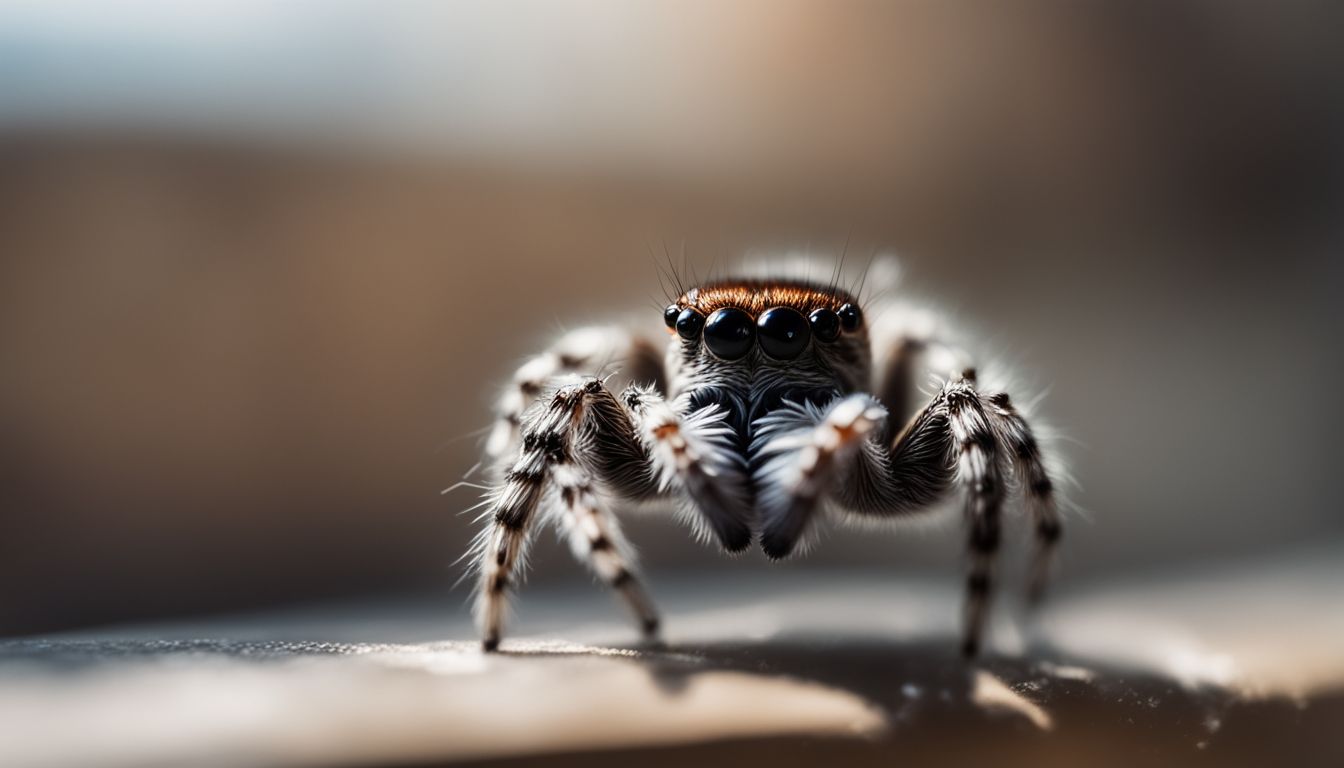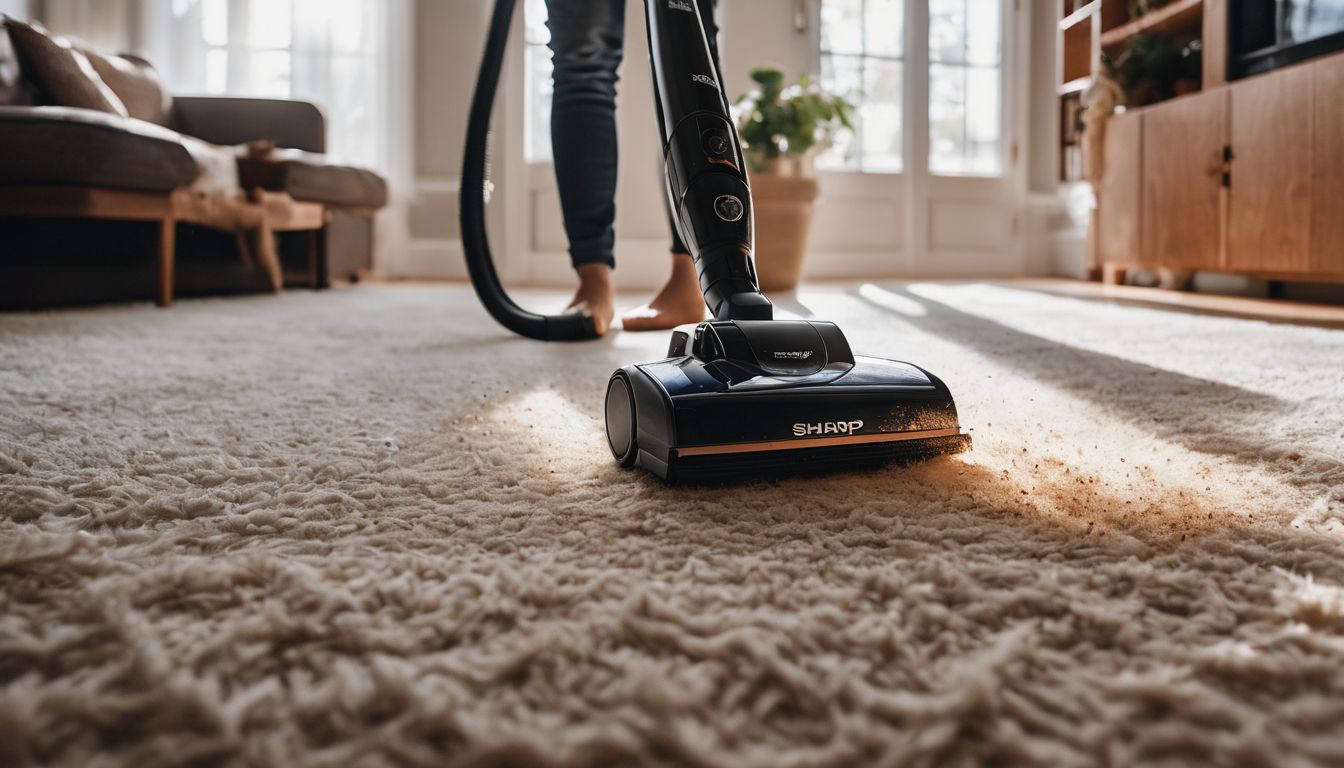Jumping spiders may be cute to some, but not when they’ve made themselves at home in your space. These tiny arachnids with their impressive jumps can startle and bother even the bravest souls.
Our guide is packed with simple yet effective methods to send these unwanted guests packing. Keep reading; a spider-free home awaits!
Key Takeaways
- Understand the behavior and habits of jumping spiders to effectively control them.
- Implement physical barriers, environmental modifications, and DIY or green solutions for jumping spider control at home.
- Seek professional pest control services if DIY methods do not effectively manage jumping spider infestations.
Understanding Jumping Spiders

Jumping spiders are small, agile arachnids known for their excellent eyesight and impressive hunting techniques. They can be found in a variety of habitats and have unique physical characteristics that set them apart from other spider species.
Understanding their behavior and habits is essential for effective control methods.
Appearance and Behavior
Jumping spiders have strong eyesight which they use to sneak up and leap on their prey. They are small, able hunters that can see very well. This helps them catch insects, like flies and aphids, by using surprise jumps.
These spiders do not just hunt with speed; they also show smart behavior. Some can plan ahead like bigger animals. They figure out how to get around obstacles to find the best way to their target.
This shows that jumping spiders think more than most other tiny creatures do.
Habitats and Diet
Jumping spiders live in many places. You can find them in forests, grasslands and even where people live. They like sunny spots where they can hunt for food.
These spiders eat tiny bugs and other small spiders. They jump to catch their prey, which is why they are called jumping spiders. Their meals include insects like ants, beetles, caterpillars, and flies.
Because they don’t spin webs to catch food, they must be quick hunters on plants or the ground.
Signs of a Jumping Spider Infestation

Common signs of a jumping spider infestation include seeing them inside your home, finding their egg sacs, and noticing an increase in other pests like mosquitoes. It’s important to be able to identify these signs so you can take the necessary steps for control.
Common Signs of Presence
Jumping spiders are small but easy to spot. Look for their large front eyes and stout shape.
- See spiders on window sills: Jumping spiders like to hang out where the sun shines. So if you see them near your windows, they might be living inside.
- Find spiders on ceilings: They also climb up high. Spiders up above could mean more are hiding in your home.
- Notice them on outer walls and foundations: These spiders can appear outside too, especially on sunny sides of buildings.
- Spot spider webs in corners or under furniture: Even though jumping spiders don’t spin webs to catch food, they do make silk nests or hideouts.
- Watch for egg sacs: Tiny, silken pouches might hold baby spiders. You can find these sacs tucked away in quiet spots.
Steps for Identification
To identify jumping spiders, follow these steps:
- Thoroughly inspect indoor and outdoor areas for fast – moving spiders with unique colorations.
- Look for quick reactions and agile movements when trying to spot jumping spiders.
- Pay attention to their distinct colors, such as black, white, or metallic green.
Methods for Jumping Spider Control
To effectively control jumping spiders, you can use physical barriers and home sealing to keep them out. Additionally, making environmental modifications and using DIY or green solutions can help to reduce their presence in your home.
Physical Barriers and Home Sealing
To keep jumping spiders out, seal up cracks and holes in your home. Here’s how:
- Inspect your home for any gaps around windows, doors, and pipes.
- Use caulk to seal any openings you find to prevent spiders from entering.
- Install or repair window screens to keep spiders from coming inside.
- Ensure that crawl spaces and basements are well – sealed to deter spider entry.
- Repair any damaged vents and install mesh coverings on them.
- Trim back trees and plants that touch the house to reduce spider access points.
Environmental Modifications
After addressing physical barriers and home sealing, making environmental modifications is another crucial step in controlling jumping spiders. Here are some effective environmental modifications to discourage the presence of jumping spiders:
- Remove clutter and unnecessary items from indoor and outdoor areas to eliminate potential hiding spots for spiders.
- Repair any leaky pipes, faucets, or other sources of moisture to reduce the attractiveness of the environment for spiders.
- Trim back vegetation and branches from around the property to prevent easy access points for spiders to enter the home.
- Seal cracks and crevices in walls, windows, and doors to block potential entryways for jumping spiders.
- Use yellow or sodium vapor light bulbs for outdoor lighting as these are less attractive to insects that spiders feed on, thus reducing spider food sources.
- Keep food tightly sealed and stored properly to prevent attracting insects that may serve as prey for jumping spiders.
- Regularly clean and vacuum indoor spaces, especially corners, ceilings, behind furniture, and underneath appliances where spiders may hide or lay eggs.
- Implement natural pest control measures such as introducing predator insects like ladybugs that feed on spider prey while being harmless to humans.
DIY and Green Solutions
After considering environmental modifications, you can also try do-it-yourself (DIY) and green solutions for controlling jumping spiders. Here are some effective methods:
- Essential oils like peppermint, tea tree, or citrus can act as natural spider repellents when sprayed in areas where spiders frequent.
- Placing chestnuts or hedge apples around your home’s perimeter may discourage spiders from entering.
- Use sticky traps to capture wandering spiders and reduce their population indoors.
- Keep your home clean and clutter – free to minimize hiding spots for spiders and their prey.
- Using a mixture of vinegar and water to clean surfaces deters spiders due to its strong scent.
Colors and Items That Attract Spiders: How to Use This Knowledge in Control
Spiders like colors like black, brown, red, yellow, and green. Also, they are not fond of yellow or orange lights as compared to white or blue ones. Smell changes how spiders see colors and can help control their behavior.
You can use this knowledge to make your surroundings less appealing to jumping spiders. Understanding what attracts them can help you take steps to keep them away from your home.
6. Professional Pest Control Solutions.
Professional Pest Control Solutions
When to Seek Professional Help and Benefits of Professional Services. Read on for more expert advice on effective methods for spider control!
When to Seek Professional Help
Seek professional help if DIY methods have not effectively controlled jumping spiders in your home. If you still see a lot of spiders after trying to get rid of them yourself, it’s important to call in an expert.
Severe infestations may require chemical control that should only be handled by professionals. For comprehensive spider control and peace of mind, it’s advisable to seek the expertise of a pest control professional who can efficiently address the issue with effective solutions.
Benefits of Professional Services
When it comes to controlling jumping spider infestations, professional pest management professionals offer significant benefits. They have access to a variety of effective tools and knowledge that novices may not possess, allowing them to address the infestation thoroughly.
Professional pest control services like Pest Pros can protect homes and businesses from the damage caused by jumping spiders, keeping structures safe and comfortable for inhabitants.
Additionally, proactive spider control solutions provided by professionals help avoid major damage caused by pests and ensure the safety of humans within their environments. This can be particularly essential as professional pest control is often the most effective method for eliminating jumping spiders in the United States, offering peace of mind and reliable results to those dealing with an infestation.
Conclusion
In conclusion, removing potential hiding spots and keeping a clean environment can help reduce jumping spider populations. Using natural repellents or targeted insecticides proves effective in controlling these agile predators.
Regular maintenance and early intervention are key to managing jumping spider infestations. Taking proactive measures can ensure a spider-free living space for you and your family.
FAQs
1. What are jumping spiders?
Jumping spiders are small, quick arthropods from the family Salticidae. They have good eyesight and can leap to catch their prey.
2. Why might I want to control jumping spiders in my home?
You might want to control them because some people have allergies or fear of spiders (arachnophobia). Even though they help by eating pests, their presence can be unsettling for many.
3. How do I know if a spider bite is from a jumping spider?
A bite from a jumping spider might make your skin red and itchy, much like a mosquito bite. But most of these spiders don’t bite humans often.
4. What’s the best way to keep jumping spiders away?
Keep areas clean of cobwebs, use rodent control to lower food sources for the spiders, and reduce clutter where they could hide or lay eggs.
5. Can chemical pesticides get rid of jumping spiders?
Yes, chemicals like diazinon can work against jumping spiders but always be careful when using pesticides around your home.
6. Should I call an exterminator for help with spider control?
If you’re really worried about spiders in your house or if there are too many, calling an exterminator is a safe way to deal with them fast.




